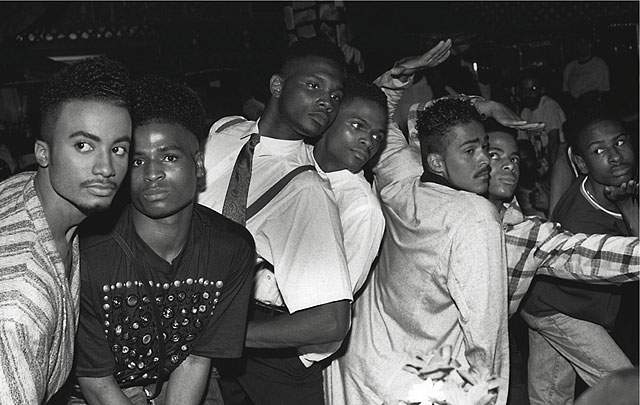|
terre thaemlitz writings 執筆 |
|
Chantal Regnault: Voguing And The House Ballroom Scene Of New York City 1989-92 Book Review for The Wire (UK) - Sprinkles |
Originally published in The Wire (UK), Issue 335, December 2011.

Voguing And The House Ballroom Scene Of New York City 1989-92
Chantal Regnault (Photographs)/Tim Lawrence (Introduction)
Soul Jazz Books Hbk 192pp
Chantal Regnault's book was promoted in pre-press under the title Voguing And The Gay Balls Of New York. That is, until Hector Xtravaganza left a two-word voice message on the answering machine at Soul Jazz Books: "Phrasing, honey". At least that's how I choose to imagine the much needed change of title came about.
I am personally attached to the themes of this book, having myself been a DJ at balls thrown by Sally Maggio's House Of Magic between 1991-92. And it seems clear that this book's publishers are aware of the various debates around how the scene self-represents and gets represented - at least to some extent - simply because the subject arises several times within its various texts. At the same time, a barometer of their level of care around these discourses is the editor's decision to miswrite the acronym AIDS throughout the book as "Aids".
As the title specifies, Regnault's photographs are from the period 1989-92. The book's graphic layout is also locked into this timeframe, its CMYK colour scheme reminiscent of Vendetta Records' vinyl centre-labels. In a used bookshop it would be difficult to visually identify this as a 2011 publication - which I like, despite not really caring for that 80s school of design itself. Stylistically, the photos fall into three main genres: journalistic photos taken at balls, formal studio portraits, and a few casual-but-posed outdoor snapshot portraits. The compositions are conventional with generally centred figures, although a bit loose in their framing and camera angles. The relationship between photographer and subject is at times warmer than mere spectator, but not much warmer (this is not to rule out the possibility of deeper relationships). In terms of both imagery and technique there is nothing scandalous, provocative or surprising here - but none of those things appear to be the book's aim. One senses these are the early works of a professional photographer, and Renault's struggle with the conventions of fashion photography at times synchronizes with the tenuous complexities of major fashion's influence on those being photographed. (Less 'fashion photography' than 'fashion photography drag'.) But, by far, the most successful photographs are the most spontaneous ones: two femme queen friends arriving in full make and t-shirts posing for a casual party snapshot (pp.46-47); a tired friend sitting on the lap of another who was lucky to have a chair (pp.78-79); a table of judges looking aloof in a moment between moments (p.100-101); a group of young butch queens horsing around (pp.166-167) - all of which point to Regnault's primary skill as a documentarian. The book's ordering of the photographs is a bit peculiar, banishing photos that were clearly from the same shoot to disparate ends of the book. This tends to rob them of any strategic sense of 'series' more than allowing them to 'stand on their own'.
Despite the circa-1990 timelock of the photographs, book design and title, the images are framed by a series of stylistically disparate texts which both elucidate and obfuscate the photos at hand. After all, while the late 80s is continually invoked as the scene's heyday, it is also the scene's greatest moment of mass cultural appropriation - which means this timeline emphasis itself must be called into question. An eight page opening essay by Tim Lawrence draws attention to the fact that the ball scene has existed for almost a century, passing through many waves of mainstream co-option and self-organisation. Tragically, this is immediately followed by a stereotypical and reductionist one page introduction by Regnault herself, which is nothing but catchphrases and buzzwords better suited for her sales pitch to the publisher than the actual book. "Everyone... giving their best to get the trophy, to get the cash, to get the fame. The competition is fierce: 10s, 10s, 10s across the board! The judges have judged!" Please... don't get me started... For me, the real strength and interest of this book - even beyond the photos themselves - lies in the 31 pages of interviews Regnault held between 2010 and 2011 with key players in the New York ball scene circa 1970-90: David Ultima, Tommie LaBeija, Hector Xtravaganza, Kevin Ultra Omni, Robbie Saint Laurent and others. Yes, these are a lot of voices that have had media attention before. And yes, there is an emphasis on House Fathers. But their stories are both informative and unpretentious. It just seems unfortunate that, in a book which chooses to mention the 'scandal' around some of the most famous mainstream representations of Voguing (Madonna's "Vogue", Livingston's "Paris Is Burning", et al), there is no attempt to critically engage itself as 'document' of a different kind. Even if Renault had asked some of the people she interviewed what they thought of her photos - or had left in her interview questions - it would have been a start. Sadly, there is no dialogue here. Old School media.
| - Sprinkles (aka Terre Thaemlitz) |